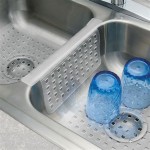Having a small kitchen sink can be a great way to save space and make the most of your kitchen. Whether you’re looking to upgrade your existing sink or are starting from scratch, there are various factors to consider when selecting the right small kitchen sink for your needs. This guide will walk you through the different components of a small kitchen sink so you can choose the best option for your kitchen.
Types of Small Kitchen Sinks
When it comes to small kitchen sinks, there are two main types to choose from: drop-in and undermount. The type you choose will depend on the layout and design of your kitchen, as well as your personal preference. Here’s a quick overview of the two types:
- Drop-in: A drop-in kitchen sink is the most common type of sink and is installed by dropping it into a pre-cut hole in the kitchen countertop. This type of sink is easy to install and is generally more affordable than an undermount sink.
- Undermount: An undermount kitchen sink is installed by mounting it beneath the kitchen countertop. This type of sink is more expensive than a drop-in sink and is more difficult to install. However, it creates a seamless and modern look.
Size of a Small Kitchen Sink
The size of a small kitchen sink is determined by the depth, width, and length of the sink. The depth of the sink should be determined based on how much space you have in your kitchen, as well as how much space you need for the dishes. The width and length should be determined based on the size of your kitchen and the layout of your countertop. The most common sizes for small kitchen sinks are 18 inches wide and 21 inches long.
Materials for a Small Kitchen Sink
The material of your small kitchen sink should be determined based on your budget, the look you’re going for, and the durability and maintenance needs of the material. The most common materials used for small kitchen sinks are stainless steel, porcelain, cast iron, and composite. Here’s a quick overview of each material:
- Stainless steel: Stainless steel is a durable and affordable material that is easy to clean and maintain. It is also available in a wide range of styles, so you can find one that fits your kitchen’s look.
- Porcelain: Porcelain is a classic material that is easy to maintain and comes in a variety of colors and finishes. It is also highly resistant to scratches and chips.
- Cast iron: Cast iron is a strong and durable material that is resistant to chips, scratches, and stains. It is also available in a variety of colors and finishes.
- Composite: Composite is a more affordable material that is made from a combination of materials such as acrylic, quartz, and granite. It is highly resistant to scratches and chips and is easy to maintain.
Maintenance of a Small Kitchen Sink
Maintaining your small kitchen sink is key to keeping it looking and functioning like new. Depending on the material you choose, the maintenance needs may vary. Generally, stainless steel and cast iron sinks should be cleaned with a mild detergent and a soft cloth, while porcelain and composite sinks should be cleaned with a non-abrasive cleaner and a soft cloth. You should also avoid using harsh chemicals or abrasive cleaning pads, as this can damage the sink.
Conclusion
Choosing the right small kitchen sink for your needs is an important decision. By considering the different types, sizes, and materials available, you can find the perfect sink for your kitchen. With the right maintenance, your small kitchen sink will stay looking and functioning like new for years to come.















Related Posts








